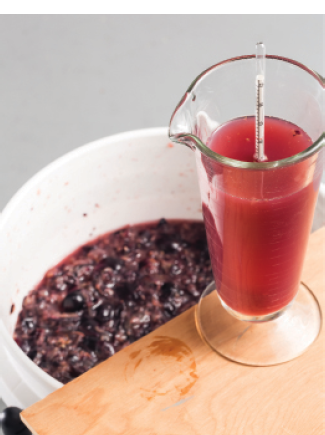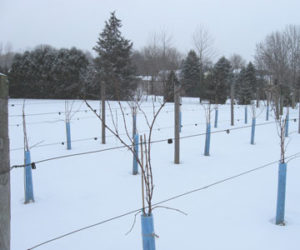
Perfectly ripe. That is how most winemakers — amateur and professional — want the grape crop to come in for every vintage. “Perfectly ripe” involves a whole host of factors. For home winemakers, the first one we usually look at is the sugar content in degrees Brix or specific gravity (SG). With some target in mind, we check the vineyard or examine the grapes we have purchased. Most grapes for dry red wines have a target somewhere in the range of 23 to 25 °Brix and most white varieties for dry or off-dry wines are targeted at about 21 to 23 °Brix.
Sugar content alone does not tell the whole ripeness story. The next factor we usually check is the titratable acidity (TA) and corresponding pH. Red wine grapes are considered about right when the TA is near 0.65 g/100 mL (0.65% or 6.5 g/L). pH will ideally be in the range of 3.4 to 3.6. White grapes are generally sought with a bit more acid and corresponding lower pH: TA of 7.0 g/L or so and pH of 3.2 to 3.4.
Beyond the basic figures for sugar and acid, ripeness includes a range of characteristics that denote “physiological maturity.” That term represents characteristics that show a fruit has reached a point for successful germination of seeds and development of a new plant. While we are not looking for a new plant, we are looking for the features that go with fruit maturity. Ripe grapes have rich, fruity aromas and well-rounded complex flavors. Under-ripe grapes often have green, vegetal aromas and flavors and can be unpleasantly herbaceous. Over-ripe grapes begin to reflect the characteristics of dried grapes: Raisins. They have cooked, jammy, or stewed aromas and flavors, reminding tasters of raisins, prunes, or dried cranberries. In the physiology of the ripening grapes, most of these changes represent development and evolution of different classes of phenolic compounds, representing phenolic ripeness. Color shows the development of desirable anthocyanins, browning of stems and seeds exhibit tannin maturation, and the loss of green-pepper aromas represents declining pyrazine levels. With all of these changes, here are some winemaking decisions if you find that you have other than perfectly ripe grapes.
Under-ripe
This condition will most often manifest as a sugar level too low to achieve the desired alcohol in the finished wine. It will be accompanied by a high TA and a low pH, which can inhibit fermentation by many wine yeasts. In making your wine, you will want to take into account, and try to correct, herbaceous or green notes that might mar the finished product. For grapes like Syrah or Cabernet Sauvignon that have too little sugar and too much acid for red wine, the best option may be making a rosé. Champagne and other sparkling wines that are refermented in bottles or in tanks are also typically produced from grapes at the lower end of the ripeness scale to keep that refreshing acidity and to account for the extra alcohol, in the order of 1.5%, that will be produced from the addition of sugar.
In correcting sugar and acid for conventional wines, I recommend not pushing any further than needed for an acceptable outcome. Suppose, for instance, that you will make a Zinfandel wine and you would like a Brix of about 25 to target a robust alcohol level of around 14% ABV (alcohol by volume). Instead, you have grapes at 17 °Brix. With an expected alcohol from that sugar level of only about 9.4%, you will need to add at least some sugar to get into standard “table wine” territory. No matter what you do, the finished wine will show characteristics of less-mature fruit. Whatever balance you can achieve will likely be better if you stay somewhat near the harvest characteristics rather than going out of balance with an oddly high alcohol. Settle for adding sugar to achieve 20 or 21 °Brix and a potential alcohol of around 11% ABV.
The next factor to consider is the acid level. If the pH is below 3.1 or the TA above 10 g/L, you will probably need to de-acidify. While a number of options are available (see the February-March 2016 “Advanced Winemaking” for details), the simple addition of potassium carbonate is one basic approach. Adding 3.4 g of potassium carbonate per gallon (0.9 g/L) of juice will lower the TA by about 0.1 g/100 mL and will usually raise the pH by about 0.1 pH. Do not use carbonates for more than about a 0.2 g/100 mL TA adjustment as bitter, salty flavors may result.
Other decisions in your winemaking may be directed at reducing unripe flavors and improving the perception of fruitiness. With under-mature grapes, the cluster stems will probably be green and flexible, rather than brown and woody. Thorough destemming at crushing is very important to avoid introducing these green stems into the ferment. To help extract fruit characteristics from the grapes, consider using a cold soak, addition of pre-fermentation macerating enzyme products, or both. You may be able to balance out some of the green notes by adding oak powder or chips or sacrificial tannin products during the primary fermentation. Select a yeast strain that is tolerant of low pH to avoid fermentation becoming stuck. A slower yeast rather than a fast one can also be helpful in providing longer contact with skins to get out the maximum available amounts of flavor and aroma compounds. For the same purpose, you can finish your fermentation with an extended maceration — holding the wine cold under a blanket of CO2 after fermentation is substantially complete — prior to pressing.
After pressing, taste and smell the wine to see if further efforts to reduce vegetal character will be needed. Aging in an oak barrel or adding an oak alternative product can sometimes mask green notes. If the low ripeness expresses as astringency, fining with PVPP (polyvinylpolypyrrolidone) can efficiently remove it and, because it acts immediately, you can test the results soon after addition. For slower and gentler treatment of astringency or bitterness, a protein agent such as egg whites, gelatin, or milk can help mellow the wine. Milk has a particular advantage in this situation, since a small amount of non-fermentable lactose will dissolve in the wine, introducing a sweetness that may seem like fruitiness on the palate. If none of these steps are sufficient, try sweetening the wine for a more fruity impression.
If your wine is still too herbaceous or too low in alcohol, there are a couple of more extreme steps you can take. I have successfully added grape concentrate to a finished wine, inoculated with a vigorous yeast strain, and re-fermented to produce a wine of higher alcohol and richer flavors. Blending is also a possibility, either with a wine that you happen to have on hand or one that you make specifically to balance your under-ripe wine.
Over-ripe
The condition of over-ripeness is most apparent as high sugar levels. At the same time, acid is likely to be low and pH may be too high for good finished wine stability. Some grape varieties, such as Zinfandel or Primitivo, seem particularly prone to producing raisins in the clusters as harvest approaches. As a result, a field sample of crushed berries may show an acceptable sugar level that turns out to underestimate the final sugar level after harvest when raisins soak up and release their concentrated sugars into the must.
Your first decision is to add water. Distilled or reverse-osmosis demineralized water is a much better choice than tap water, which may contain minerals or chlorine that will affect the flavor of the wine. Demineralized water replaces the pure water lost to dehydration from the raisins. You will also need to add tartaric acid. At a minimum, add acid to the water you are using to simulate a wine level; about 0.6 g/100 mL. Since over-mature fruit is most likely low in acid anyway, you will need to measure the TA of the crushed must and probably add more acid as well. Since a must containing raisins may not immediately release all the sugar, add your first increment of water right after crushing.After the combined must and water soak for a few more hours or overnight, check the Brix level again and make another water addition if needed. Once again, do not try for an extreme adjustment. If the Brix of your crushed must is 27, you will probably be happier with adding water only to 24.5 or 25 °Brix, rather than taking it all the way down to something like 23. Of course, if you make a second water addition, double check the TA and pH and be prepared to make another acid addition as well.
To deal with raisiny or stewed-fruit flavors and aromas, there are not many options available. However, there are versions for very ripe fruit as well, where these flavors and aromas may not be objectionable. You can consider making a Port-style or late harvest wine, for instance. In those cases, go for complete extraction and conventional red-wine fermentation, adding sugar or distilled spirits if necessary to get the balance of alcohol and sweetness that you choose. If that is not your choice, and your table wine comes out too jammy or too high in alcohol, consider blending with another wine made from less-ripe grapes. One way or another, you will probably be able to make a rewarding adult beverage from your fruit, whatever the ripeness at harvest.






